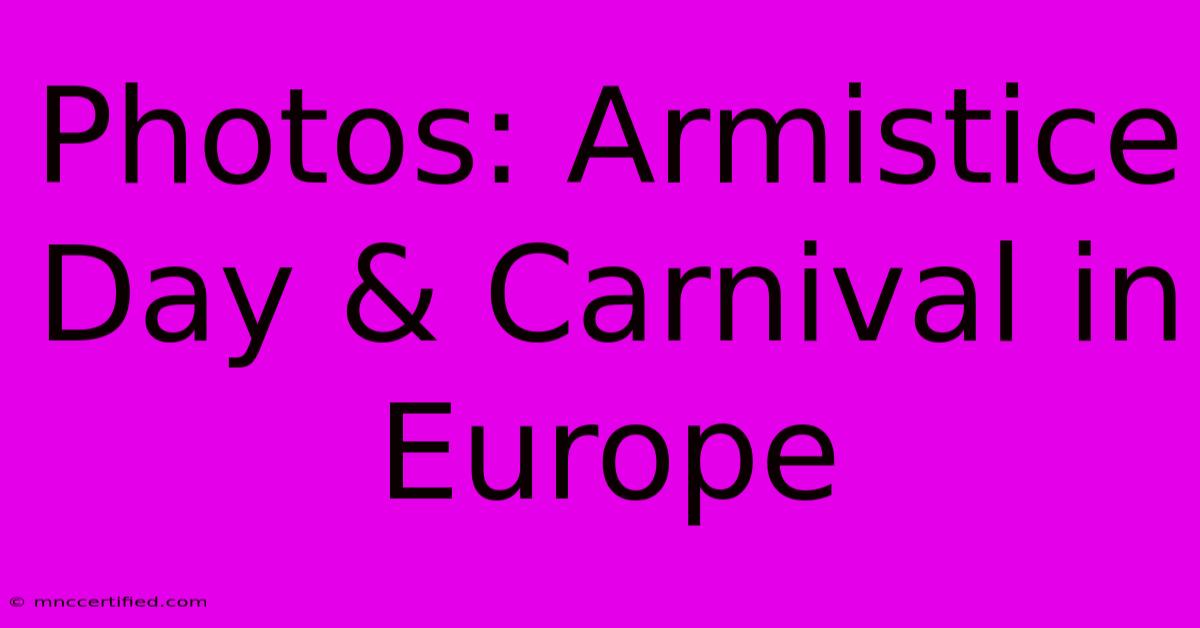Photos: Armistice Day & Carnival In Europe

Table of Contents
A Visual Journey: Armistice Day and Carnival in Europe
Europe, with its rich history and vibrant culture, offers a captivating tapestry of traditions and festivities. November 11th, a day marked by solemn remembrance as Armistice Day, stands in stark contrast to the joyous revelry of Carnival, which explodes across the continent in the weeks leading up to Lent. This article delves into these two contrasting celebrations, capturing their essence through a collection of stunning photographs.
The Solemnity of Armistice Day: A Tribute to Peace
Armistice Day, also known as Remembrance Day in many countries, commemorates the end of World War I. On the 11th hour of the 11th day of the 11th month in 1918, an armistice agreement was signed, effectively ending the "Great War".
Across Europe, various ceremonies and memorials are held to honor the soldiers who fought and perished in the conflict. Poppy wreaths are laid at war memorials, minute silences are observed, and military parades take place, all serving as powerful reminders of the sacrifices made for peace.
Here are some poignant photographs capturing the solemnity of Armistice Day across Europe:
- The Cenotaph in London: A majestic monument in Whitehall, London, serves as a poignant focal point for the Remembrance Sunday ceremony, where the Queen lays a wreath and the nation observes a two-minute silence.
- The Tomb of the Unknown Soldier in Paris: A flame burns eternally at this memorial, a symbol of respect for all those who died in World War I and later conflicts.
- The Flanders Fields in Belgium: The fields of Flanders, where countless soldiers lost their lives, are a somber reminder of the brutality of war. The sight of poppy fields blooming annually evokes the poignant poem, "In Flanders Fields."
The Unbridled Joy of Carnival: A Celebration of Life
In stark contrast to the somber tones of Armistice Day, Carnival explodes with vibrant colors, exuberant music, and joyous revelry. This ancient tradition, rooted in pre-Lenten celebrations, marks a period of indulgence and festivity before the austerity of Lent.
Carnival is a celebration of life, with elaborate costumes, masked balls, street parades, and delicious food taking center stage. It's a time for letting loose, embracing the absurdity, and enjoying the company of friends and family.
Here are some joyous images showcasing the unique spirit of Carnival across Europe:
- Venice Carnival: The iconic masked balls and elaborate costumes of the Venice Carnival are world-renowned, transporting visitors to a bygone era of elegance and intrigue.
- Rio de Janeiro Carnival: While technically not in Europe, Rio's Carnival holds a special place in the hearts of many, with its spectacular parades, samba music, and vibrant costumes.
- Cologne Carnival: Known for its "Rose Monday" parade, Cologne Carnival features satirical floats, lively music, and an abundance of beer, making it a truly unforgettable experience.
A Journey Through Time and Tradition
Armistice Day and Carnival offer a fascinating glimpse into the contrasting facets of European culture. The solemnity of Armistice Day reminds us of the sacrifices made for peace, while the exuberance of Carnival reflects the joyous spirit of humanity. Both traditions are integral to the European fabric, shaping the continent's history, identity, and artistic expressions.
To further explore the captivating world of these European celebrations, search for images and videos online, visit museums dedicated to World War I history, or immerse yourself in the vibrant atmosphere of a Carnival celebration.
By experiencing these events firsthand, you can gain a deeper understanding of the richness and complexity of Europe's cultural tapestry.

Thank you for visiting our website wich cover about Photos: Armistice Day & Carnival In Europe. We hope the information provided has been useful to you. Feel free to contact us if you have any questions or need further assistance. See you next time and dont miss to bookmark.
Featured Posts
-
Messis Miami Eliminated In Mls Playoffs
Nov 12, 2024
-
Megaman Nt Warrior Trading Card Game
Nov 12, 2024
-
Amorim Replaces Van Nistelrooy At Man Utd
Nov 12, 2024
-
Standard Guaranty Insurance Company
Nov 12, 2024
-
Border Czar Top Aide Named By Trump
Nov 12, 2024